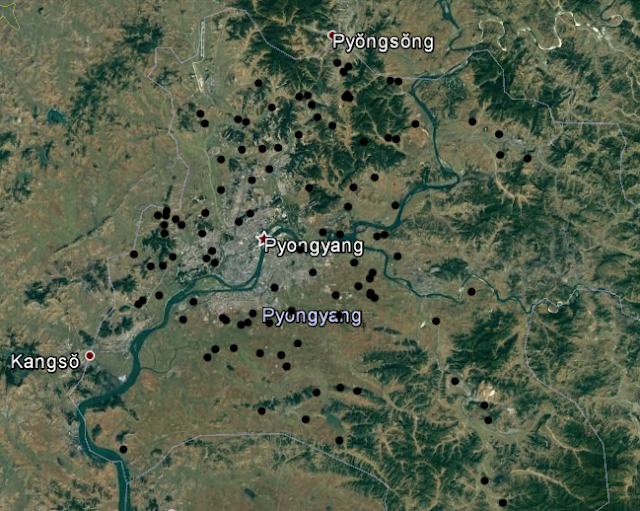North Korea is more than just some rouge state hellbent on gaining nuclear weapons. It's a dynamic country with 25 million people, all of whom share a 2,100 year history with 50 million of their southern brethren. And, yes, they also have a deep military state that is always seeking ways to hide their more dangerous activities. And because of all of this, things change - and much remains unknown. Current collections of nation-wide data are years out of date and resources like Google Maps are often woefully inadequate.
Because their military activities tend to get the outside world to pay attention more than anything, I think the best example of the benefits of the #AccessDPRK Mapping Project is to show how some of these military areas have drastically changed over the last decade.
This image shows each of the 318 active anti-aircraft artillery batteries in Pyongyang.
And this shows each of the 108 decommissioned artillery batteries in the area.
Because of the reliance on older maps and information, just about every crowd-sourced mapping site (Wikimapia, Openstreet, etc) has these inactive places marked. Several of them have been completely demolished and turned into farm land but exists on maps as artillery sites!
It's not just Pyongyang. I have located 386 decommissioned artillery sites all over North Korea, many of them, unfortunately, are on maps. Furthermore, of the 1,358 known active sites, some 500 aren't on any map.
On the domestic side, hundreds of additional dams and hydroelectric power stations can be accounted for. Here are some in Chagang Province:
And speaking of the shared history of Korea, #AccessDPRK now has 346 ancient sites mapped - an increase of 119 new places found since my article on the subject back in February 2016. As far as I have been able to find, at least half of these sites aren't on any maps available online (or anywhere else that I can find). This doesn't include hundreds of centuries old burial mounds and tombs either.
Furthermore, the project will also allow people to see some of the tremendous natural changes that have occurred, like an enormous landslide in the ecologically important Mt. Chilbo National Park, or the damage done in recent flooding.
It would be difficult to detail every value of a map with over 50,000 places marked, but I hope I've adequately expressed the point of this effort.
--Jacob Bogle 1/27/17




EmoticonEmoticon